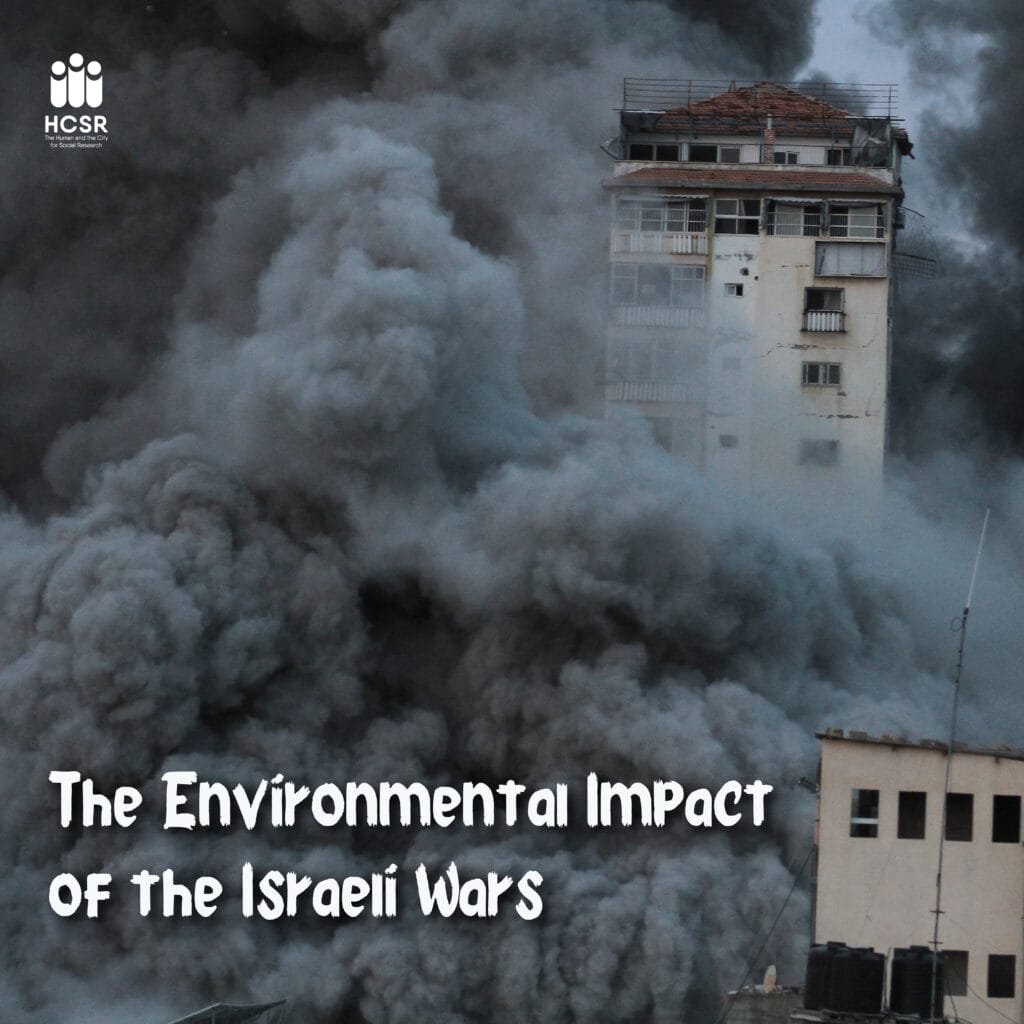The Environmental Impact of the Israeli Wars

A whole year of environmental destruction in the region renders any environmental talks or campaigns mere nonsense. The significant and ongoing environmental damages of what the occupying entity has been doing in Gaza for the past 12 months, and what it is currently doing in Lebanon, could reach the entire planet and the region in particular, akin to what fossil fuels and plastic could do for years. These result in catastrophic effects on the region as a whole, as well as on the ecosystems of the Mediterranean, and vital infrastructure, directly threatening the health and lives of the people of Gaza and Lebanon. The Israeli army observes the “scorched earth policy” to destroy what it cannot occupy, including land, crops, natural resources, and infrastructure, notwithstanding the environmental impact that extends to the areas it controls, and expands to encompass the entire region. Land: 1- Military operations have led to soil contamination with heavy metals such as lead and mercury, along with toxic chemicals, causing soil infertility and chronic diseases including cancer. 2- Military operations in Gaza have destroyed over 42% of agricultural and arable lands in Gaza, with the United Nations estimating losses from these damages at nearly 629 million USD until June 2024. 3- Military operations have destroyed nearly 90% of olive tree agricultural lands in various areas of the Gaza Strip, depriving the people of Gaza of olive harvesting for the second consecutive year. Olive trees take at least five years to bear fruit. The destruction of olive trees affects the environmental balance, increases desertification, and negatively impacts biodiversity, not to mention the economic aspect and the population’s reliance on the crop. 4- The Israeli crimes have turned Gaza’s land into dangerously polluted land, affecting health and destroying the food security of the area, thus its dependence on food aid post-war for long decades, indicating that the war of starvation continues even after the war of arms. Additionally, all what is happening to Gaza’s land has a direct impact on the environmental balance of the region, including lands under the Israeli control. Water: 57% of water facilities, including desalination plants, wells, and water networks, have been destroyed, leading to a severe water shortage. Over 162 wells have been destroyed, in addition to the 3 main water desalination plants in Gaza, resulting in a loss of 95% of the water production capacity in Gaza Strip and estimated losses of 503 million USD. Groundwater contamination with heavy metals and chemicals resulting from military operations renders 97% of water in Gaza undrinkable for humans, animals, or irrigation. According to the World Health Organization, nitrate levels are 6 times higher than the permissible limit. Cases of waterborne diseases, such as diarrhea and hepatitis, have indeed increased due to water pollution. Pollution from sewage water and chemicals leads to groundwater contamination. The collapse of sewage treatment networks has led to the discharge of 60,000 cubic meters of untreated water daily into the Mediterranean Sea, causing pollution and destruction of marine habitats. Estimates indicate that 25% of the sea water near Gaza has become contaminated with harmful bacteria and heavy metals. Pollution can be carried through marine currents to neighboring countries in the Mediterranean Sea, such as Egypt, Lebanon, Turkey, and Greece, threatening water quality and fish resources in these countries. Moreover, Israel heavily relies on sea water desalination plants that it pollutes, endangering everyone’s lives. Air Pollution: 1- Continuous bombing, explosions, and airborne dust from the rubble have led to the release of thousands of tons of fine particles and chemicals into the air, including sulfur dioxide, nitrogen oxides, and toxic particles such as asbestos. 2- The number of fires due to the aggression from October 2023 to only January 2024 reached 165 fires, including 19 in industrial areas, resulting in air pollution with toxic chemicals. 3- This pollution poses a significant risk to the respiratory health of the population, especially with continued inhalation of fine particles. Hospitals have witnessed a 300% increase in respiratory diseases and asthma cases during the first three months of the aggression alone, affecting over 179,000 individuals, including children and the elderly. 4- The total rubble generated by military attacks has exceeded 39.2 million tons, equivalent to over 10 pyramids of Giza. This quantity also covers more than 365 square kilometers, the total area of Gaza, with a height exceeding one meter of rubble, which is 13 times more than the total rubble resulting from all previous wars since 2008. The rubble contains hazardous materials including over 800,000 tons of potential asbestos and unexploded ordnance (UXOs). Airborne dust poses a respiratory hazard, especially with the presence of toxic substances. These materials will continue to pose a health risk to the population for decades to come. 5- Approximately 1,100 to 1,200 tons of waste accumulate daily in the affected areas, including 400 tons daily in displacement sites alone. Over 1.5 tons of contaminated medical waste are left untreated every day in hospitals, increasing the risk of spreading infectious diseases and hazardous chemicals. With waste transportation issues unresolved, residents resort to burning waste outdoors, further complicating the issue of air pollution. 6- Air pollution spreads to neighboring countries with the wind, including territories under Israeli occupation in the West Bank, Egypt, Jordan, Lebanon, Syria, Turkey, and Greece. 7- Toxic gases emissions and fine particles resulting from destruction may contribute to rising temperatures, and exacerbate the effects of climate change in the Mediterranean region, contributing to global climate change. It is worth mentioning that the above information is the latest recorded data, not to mention the damages that are yet undocumented, or the updated damages caused by the failure of the international community to stop the year-long ongoing genocide. The environmental impact of the war on Gaza requires a rapid and comprehensive intervention to protect the population and the environment in the short and long term. The international community has to take urgent measures to provide support and assistance in rebuilding the environmental infrastructure and enhancing the protection of natural
World Day of Social Justice| 2023
The 20th of February was marked as the World Social Justice Day by the General Assembly of the United Nations in 2007. This year’s theme is “Overcoming Barriers and Unleashing Social Justice Opportunities“, as the global trend of global development, which depends on achieving the sustainable development goals by reaching 2030, takes into account the great transformations that have occurred during previous years, which affected the performance of many countries at the level of economy and at the level of justice as well, which makes us more aware that social justice may be the way to remedy road difficulties and build more effective mechanisms. The absence of social justice directly affects the achievement of the basic goals of sustainable development; it reinforces poverty, makes it difficult to fight global hunger, and impedes the process of comprehensive development. According to the official website of the United Nations, the World Day of Social Justice provides an opportunity to enhance dialogue, especially with social partners and civil society organizations, which enhances everyone’s ability to strengthen the social contract that is struggling to survive, especially with the outbreak of conflicts, the rise of many currents, and major economic transformations at local levels, especially with the intense global anticipation of recession and depression expected to affect more than two-thirds of the world’s countries. In Egypt, for example, the Human Development Report, issued by the United Nations Development Programme (UNDP) in partnership with the Ministry of Planning, indicates a decline in the human development index according to wage equity during the previous decade 2010-2020, while monitoring macroeconomic resilience during the Corona crisis, which significantly affected most international economies. This report confirms what we seek to point out and work to solve, which is the gap between the macroeconomics of the state and the micromechanisms in society, as we believe that community participation– at all levels of disseminating information and awareness and contributing to planning, control and governance- may be the solution to the challenges ahead.


